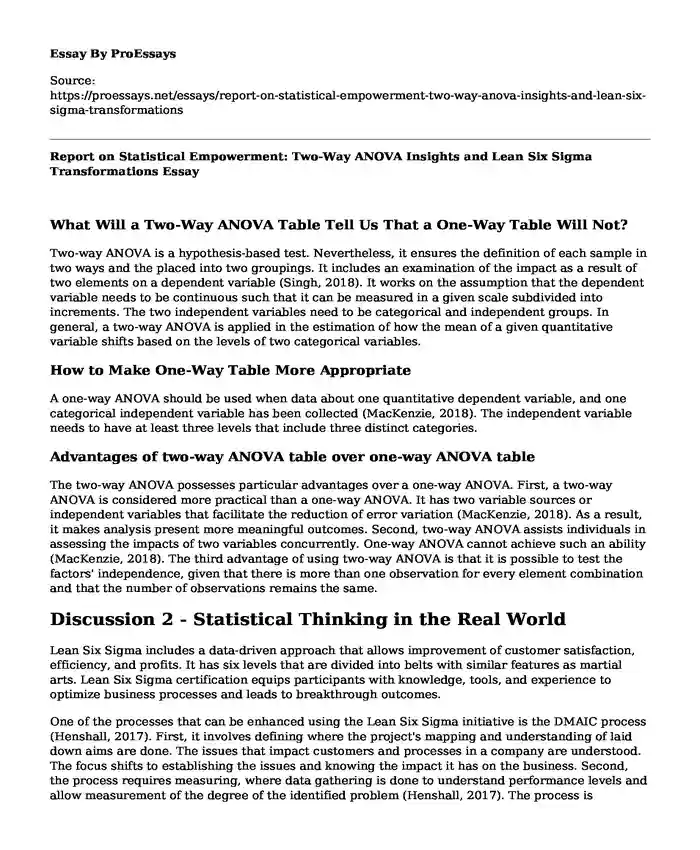What Will a Two-Way ANOVA Table Tell Us That a One-Way Table Will Not?
Two-way ANOVA is a hypothesis-based test. Nevertheless, it ensures the definition of each sample in two ways and the placed into two groupings. It includes an examination of the impact as a result of two elements on a dependent variable (Singh, 2018). It works on the assumption that the dependent variable needs to be continuous such that it can be measured in a given scale subdivided into increments. The two independent variables need to be categorical and independent groups. In general, a two-way ANOVA is applied in the estimation of how the mean of a given quantitative variable shifts based on the levels of two categorical variables.
How to Make One-Way Table More Appropriate
A one-way ANOVA should be used when data about one quantitative dependent variable, and one categorical independent variable has been collected (MacKenzie, 2018). The independent variable needs to have at least three levels that include three distinct categories.
Advantages of two-way ANOVA table over one-way ANOVA table
The two-way ANOVA possesses particular advantages over a one-way ANOVA. First, a two-way ANOVA is considered more practical than a one-way ANOVA. It has two variable sources or independent variables that facilitate the reduction of error variation (MacKenzie, 2018). As a result, it makes analysis present more meaningful outcomes. Second, two-way ANOVA assists individuals in assessing the impacts of two variables concurrently. One-way ANOVA cannot achieve such an ability (MacKenzie, 2018). The third advantage of using two-way ANOVA is that it is possible to test the factors' independence, given that there is more than one observation for every element combination and that the number of observations remains the same.
Discussion 2 - Statistical Thinking in the Real World
Lean Six Sigma includes a data-driven approach that allows improvement of customer satisfaction, efficiency, and profits. It has six levels that are divided into belts with similar features as martial arts. Lean Six Sigma certification equips participants with knowledge, tools, and experience to optimize business processes and leads to breakthrough outcomes.
One of the processes that can be enhanced using the Lean Six Sigma initiative is the DMAIC process (Henshall, 2017). First, it involves defining where the project's mapping and understanding of laid down aims are done. The issues that impact customers and processes in a company are understood. The focus shifts to establishing the issues and knowing the impact it has on the business. Second, the process requires measuring, where data gathering is done to understand performance levels and allow measurement of the degree of the identified problem (Henshall, 2017). The process is examined in the current state to establish its performance patterns. The third step involves analysis to understand where the issues of a process lie. It can be done using a Pareto chart, value stream map, process map, or fishbone diagram (Seif, 2018). Fourth, improvement is required by working out reduction and solving the issue (Henshall, 2017). The last step includes a control that describes planning ways to implement and keep the solution. Processes need to be standardized and documented to ensure every step achieves proper documentation and mapping out in an actionable manner.
References
Henshall, A. (2017, November 24). DMAIC: The complete guide to Lean Six Sigma in 5 key steps. Process Street. Retrieved on February 7, 2020 from https://www.process.st/dmaic/
MacKenzie, R. (2018, July 20). One-way vs two-way ANOVA: Differences, assumptions, and hypothesis. Technology Network. Retrieved on February 18, 2020 from https://www.technologynetworks.com/informatics/articles/one-way-vs-two-way-anova-definition-differences-assumptions-and-hypotheses-306553
Seif, G. (2018, October 21). The 5 basic statistic concepts data scientists need to know. Towards Data Science. Retrieved on February 7, 2020 from https://towardsdatascience.com/the-5-basic-statistics-concepts-data-scientists-need-to-know-2c96740377ae
Singh, G. (2018). A simple introduction to ANOVA. Analyticsvidhya.com. https://www.analyticsvidhya.com/blog/2018/01/anova-analysis-of-variance/
Cite this page
Report on Statistical Empowerment: Two-Way ANOVA Insights and Lean Six Sigma Transformations. (2024, Jan 09). Retrieved from https://proessays.net/essays/report-on-statistical-empowerment-two-way-anova-insights-and-lean-six-sigma-transformations
If you are the original author of this essay and no longer wish to have it published on the ProEssays website, please click below to request its removal:
- Evaluation of the the Peninsula Hotels Marketing Communications
- TechStars Startup Weekend: Innovation and Entrepreneurship Paper Example
- Essay Example on Asia and America: Top Economies & Markets for Business Investments
- Descriptive Statistics: Summarizing Research Data Into Graphs & Charts - Essay Sample
- Examining BOH Tech Utilization in US Restaurants - Essay Sample
- Essay Example on Lockheed Martin: Reinventing Itself Through Ethical Knowledge and Responsibility
- Become an Entrepreneur: Pursuing Business Management - Admission Essay Sample







